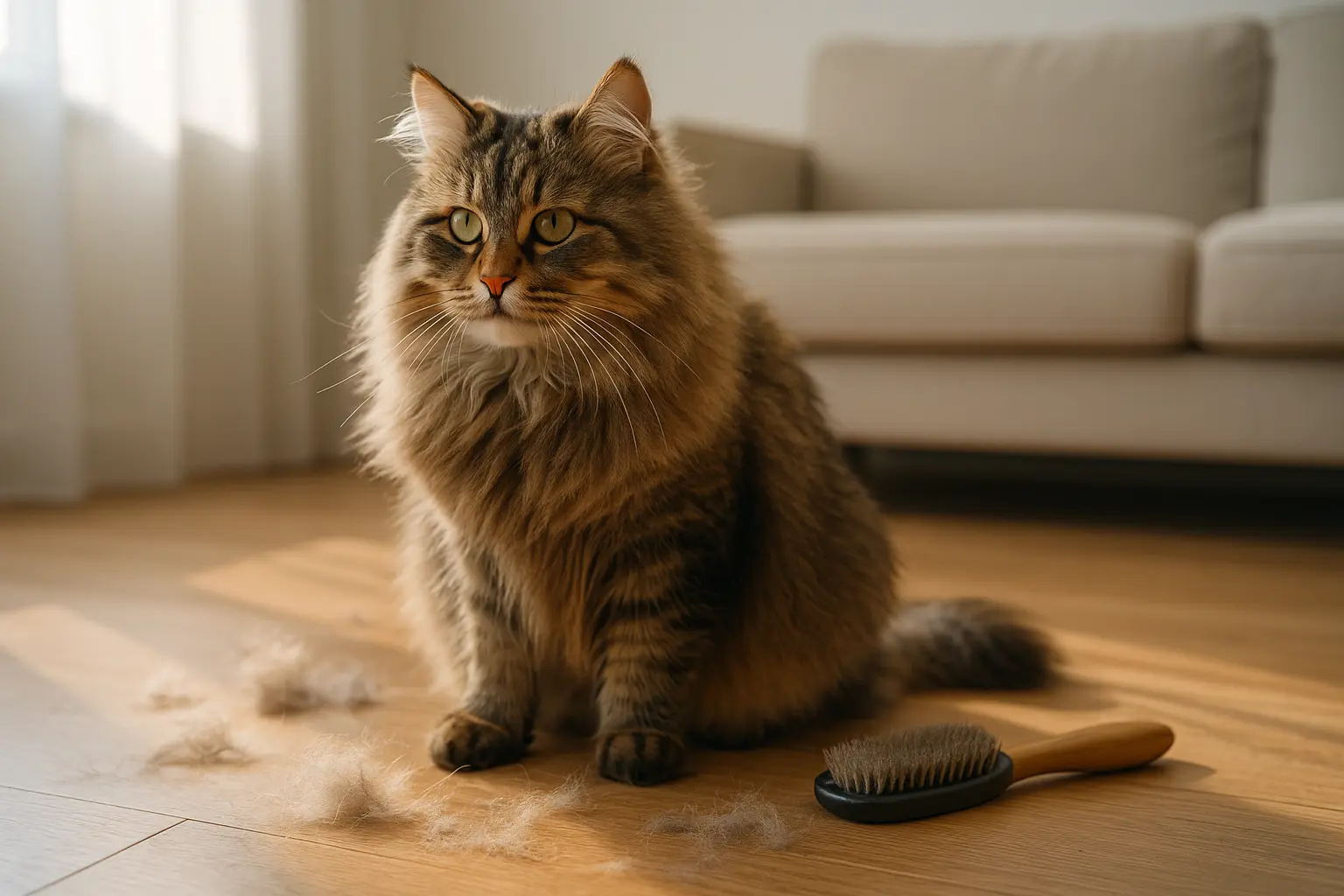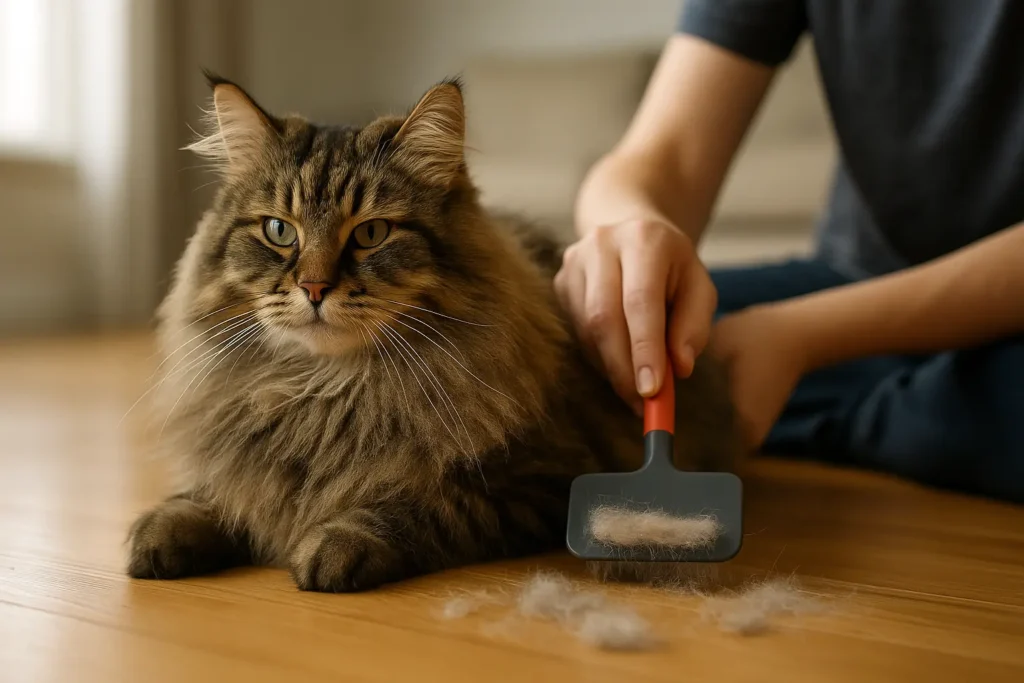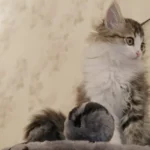
Siberian Cat Shedding Guide: How Much, When & How to Manage It Effectively

Siberian cats shed, particularly at the season change, such as spring and fall, although shedding is usually lighter and easier than most other long-haired breeds. Their thick triple-layered coat and inherently low concentration of allergenic proteins make them the favorite of allergy-sensitive cat lovers.
These mighty cats are also affectionate and luxurious, yet it is necessary to know how they shed to take good care of them. We will discuss in this guide what makes Siberian cats shed, when it occurs most, and how you can easily handle it, keeping both your house and your cat at its best level.
Key Highlights
- Siberian cats have an average shedding of hair all year round, but more so during the spring and fall.
- Their triple coat, the undercoat, the guard coat, and the topcoat, motivate seasonal shedding.
- Regular grooming during the peak seasons will assist in controlling shedding and avoiding mats.
- Siberians are low-allergen, yet shed and generate a few allergens.
Do Siberian Cats Shed? Debunking the Hypoallergenic Myth
Yes, Siberian cats drop, like most cats, but are sold as hypoallergenic. This does not imply they do not shed or that they are totally allergy-free. This is due to the presence of a cat saliva protein called Fel d 1, present in the dander. Research indicates that Siberians do not secrete this protein as much, hence they are more tolerable to some allergy victims.
However, we must be explicit: shedding remains, and more so in their case, with their large triple-layered coat. The myth that they do not shed at all is a mere myth.
Key Point: Siberians are low-allergen, not non-shedding.
Why Do Siberian Cats Shed So Much?
Understanding the Siberian cat shed cycle starts with their triple coat, which includes:
- A soft, dense undercoat (for insulation)
- A middle guard coat
- A coarse topcoat that repels water
Several factors trigger this shedding cycle:
1. Seasonal Changes
During spring and fall, Siberian cats shed much hair because in warm or cold seasons, cats are ready to go. This is a natural process, which is seasonal moulting.
2. Indoor Living Conditions
Indoor cats that are kept as full-time indoor pets might shed regularly because of the influence of artificial light and air conditioning/heating systems, which interfere with natural rhythms.
3. Diet & Hydration
Excessive loss of fur may result from poor nutrition, dehydration, or a deficiency of one or more of the necessary fatty acids.
4. Stress or Health Issues
Both excessive shedding and stress or skin conditions could also be a sign of allergies. When your Siberian cat begins to shed in chunks or acquires bald patches, get it checked by a vet.
Siberian Cat Shedding Timeline (Month-by-Month Guide)
Siberian cats don’t shed uniformly year-round. Their fur changes with the seasons. Here’s a general Siberian cat shed timeline:
| Month | Shedding Intensity | Coat Behavior |
|---|---|---|
| January–March | Low to Moderate | Building winter coat |
| April–May | High | Spring molt (shedding winter coat) |
| June–August | Moderate | Sleeker summer coat maintained |
| September–October | High | Fall molt (growing winter coat) |
| November–December | Moderate to Low | Coat thickens for winter |
Pro Tip: Track shedding periods with a calendar and adjust grooming accordingly.

How to Control Siberian Cat Shedding at Home
It is all about regular care when it comes to managing a Siberian cat’s shed. The following is a time-tested house routine to trim the fur around your house and ensure your cat feels at home.
Daily Brushing (During Molting Seasons)
Apply a grooming glove or slicker brush every day in the spring and fall. Attend to the undercoat to avoid matting.
Weekly Grooming (Year-Round)
The undercoat rake/deshedding tool is used to get the dead fur that is stuck behind the top coat. Use together with a large-tooth comb in delicate places such as the belly or tail.
Bathe Occasionally
Although Siberians take care of their own grooming, a bath once every 2-3 months (with a gentle shampoo that is cat-safe) can help loosen fur, particularly when shedding seasonally.
Improve Nutrition
Eat a good diet that contains Omega-3 and Omega-6 fatty acids to promote skin and coat condition. Wet food is also beneficial to hydration.
Clean Environment
Wipe with lint rollers, grooming mats, and vacuum pet hair regularly to keep up with loose fur in and around your home.
Best Grooming Tools for Siberian Cats
To effectively manage Siberian cat shedding, the right tools make all the difference. Here are expert approved grooming essentials for long-haired breeds:
| Tool | Best Use Case |
|---|---|
| Slicker Brush | Daily brushing, removes loose hair on topcoat |
| Undercoat Rake | Deep grooming for dense undercoat |
| Deshedding Tool | Heavy seasonal shedding control |
| Grooming Glove | Light brushing, good for bonding |
| Wide-Tooth Comb | Sensitive areas like legs and belly |
Tip: Rotate tools weekly and watch how your cat reacts—some prefer gentler brushes.
Are Siberian Cats Hypoallergenic Despite Shedding?
The word hypoallergenic is a confusing concept to many. Siberian cats also shed, although research indicates that they have less production of Fel d 1, the protein that causes allergy in humans.
Here’s how to reduce allergen exposure:
- Wipe your cat’s coat with a damp cloth once a week
- Use HEPA filters at home
- Wash bedding regularly
- Avoid letting your cat sleep on pillows or soft furniture
Despite frequent shedding, most allergy sufferers claim to have a high level of tolerance to Siberians than to other breeds.
Conclusion
Yes, Siberian cats shed particularly during the seasons, and when groomed, on the right diet and tools, it is not that difficult. Their plump coat is included in their inherent attractiveness, and grooming can even enhance your relationship with your cat.
Knowing the Siberian cat shedding schedule and applying some of the best methods will give you a cleaner house and a healthier, happier feline companion.
Curious about Siberian cat coat colors and how they affect pricing? Check out our full guide on Siberian Cat Colors and Price.
FAQs
In the months of heavy shedding (spring/fall), brush every day. One or two times a week suffices in other months.
No, a Siberian should not be shaved. Their coat offers a means of temperature regulation and protection.
Neutering can affect hormone-driven shedding, but does not completely remove it.
Patchy or sudden loss of fur can be a sign of allergies, stress, or some underlying illness. See a vet when shedding is abnormal.
Siberian cats do not shed heavily, and shed lightly through the spring and fall. Frequent shedding is kept in check.
Siberian Cat Info – Your trusted source for expert tips, breed facts, and care guides on Siberian cats.















